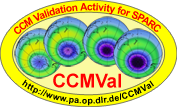 |
CCM Validation Activity for SPARC (CCMVal) |
 |
CCM Validation Activity for SPARC (CCMVal) |
|
|
| 1. |
Eyring, V., N. Butchart, D. W. Waugh,
H.
Akiyoshi, J. Austin,
S. Bekki,
G. E. Bodeker, B. A. Boville, C. Brühl, M. P. Chipperfield, E.
Cordero, M.
Dameris, M. Deushi, V. E. Fioletov, S. M. Frith, R. R. Garcia, A.
Gettelman, M.
A. Giorgetta, V. Grewe, L. Jourdain, D. E. Kinnison, E. Mancini, E.
Manzini, M.
Marchand, D. R. Marsh, T. Nagashima, P. A. Newman, J. E. Nielsen, S.
Pawson, G.
Pitari, D. A. Plummer, E. Rozanov, M. Schraner, T. G. Shepherd, K.
Shibata, R.
S. Stolarski, H. Struthers, W. Tian, and M. Yoshiki, Assessment of
temperature, trace species and ozone in chemistry-climate model
simulations of the recent past, J. Geophys. Res., 111,
D22308,
doi:10.1029/2006JD007327,
2006.
Download
Figures as eps-files (Copyright 2006 by the American Geophysical
Union): CCMAssessment_Part1_Figureseps.zip |
| 2. | Eyring, V.,
D. W. Waugh, G. E. Bodeker, E. Cordero, H. Akiyoshi, J. Austin, S. R.
Beagley, B.
Boville, P. Braesicke, C. Brühl, N. Butchart, M. P. Chipperfield,
M. Dameris, R.
Deckert, M. Deushi, S. M. Frith, R. R. Garcia, A. Gettelman, M.
Giorgetta, D. E.
Kinnison, E. Mancini, E. Manzini, D. R. Marsh, S. Matthes, T.
Nagashima,
P. A.
Newman, J. E. Nielsen, S. Pawson, G. Pitari, D. A. Plummer, E. Rozanov,
M.
Schraner, J. F. Scinocca, K. Semeniuk, T. G. Shepherd, K. Shibata, B.
Steil, R.
Stolarski, W. Tian, and M. Yoshiki Abstract: Simulations from eleven coupled chemistry-climate models (CCMs) employing nearly identical forcings have been used to project the evolution of stratospheric ozone throughout the 21st century. The model-to-model agreement in projected temperature trends is good, and all CCMs predict continued, global-mean cooling of the stratosphere over the next five decades, increasing from around 0.25 K/decade at 50 hPa to around 1 K/decade at 1 hPa under the IPCC (Intergovernmental Panel on Climate Change) SRES (Special Report on Emission Scenarios) A1B scenario. In general, the simulated ozone evolution is mainly determined by decreases in halogen concentrations and continued cooling of the global stratosphere due to increases in greenhouse gases (GHGs). Column ozone is projected to increase as stratospheric halogen concentrations return to 1980s levels. Because of ozone increases in the middle and upper stratosphere due to GHG induced cooling, total ozone averaged over mid-latitudes, outside the polar regions, and globally is projected to increase to 1980 values between 2035 and 2050 and before lower stratospheric halogen amounts decrease to 1980 values. In the polar regions, the CCMs simulate small temperature trends in the first and second half of the 21st century in mid-winter. Differences in stratospheric inorganic chlorine (Cly) among the CCMs are key to diagnosing the inter-model differences in simulated ozone recovery, in particular in the Antarctic. It is found that there are substantial quantitative differences in the simulated Cly, with the October mean Antarctic Cly peak value varying from less than 2 ppb to over 3.5 ppb in the CCMs, and the date at which the Cly returns to 1980 values varying from before 2030 to after 2050. There is a similar variation in the timing of recovery of Antarctic spring-time column ozone back to 1980 values. As most models underestimate peak Cly near 2000, ozone recovery in the Antarctic could occur even later, between 2060 and 2070. In the Download Figures as eps-files (Copyright 2007 by the American Geophysical Union): CCMAssessment_Part2_Figureseps.zip |
| Last modified: 1 September 2007 |
|
| by Veronika
Eyring |